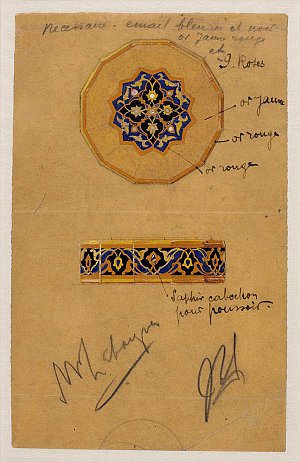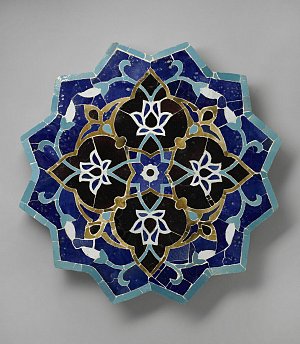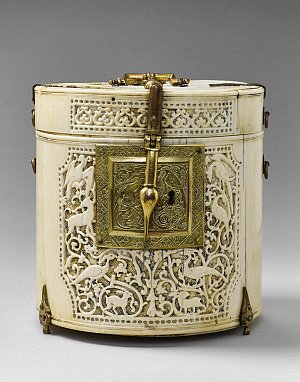
Court belt, India or Iran, 17th century
Silk, silver thread
Musée du Louvre, Paris, département des Arts
de l’Islam
© 2007 musée du Louvre / Raphaël Chipault
Founded in 1847 by Louis-François Cartier,
the House of Cartier initially specialised
in selling jewellery and works of art.
His son, Alfred, took over the management
of the business in 1874, and his eldest son,
Louis, later joined him in 1898. By that time,
Cartier was designing its own jewellery,
while continuing to resell antique pieces.
At the beginning of the 20th century,
Louis Cartier sought new inspiration.
At the time Paris was the epicentre of the
Islamic art trade and it was undoubtedly
through major exhibitions organised at the
Musée des Arts Décoratifs in Paris in 1903
and then in Munich in 1910, that Louis
enthusiastically discovered these new
shapes which were gradually spreading
throughout French society.
The exhibition is organised as a themed
chronological tour divided into two parts,
the first of which explores the origins
of this interest in Islamic art and
architecture through the cultural backdrop
of Paris at the beginning of the 20th
century and reviews the creative context
among designers and studios as they
searched for sources of inspiration.
The second part illustrates the lexicon
of forms inspired by Islamic art, from the
start of the 20th century to the present day.

Tiara, Cartier London, 1936
Platinum, diamonds, turquoise. Vincent Wulveryck. Cartier Collection
© Cartier

Proposal for a powder box, Cartier Paris, circa 1920
Graphite pencil, Indian
ink and gouache
on tracing paper.
Cartier Paris Archives
© Cartier
From the outset, visitors find themselves
immersed in these shapes and motifs
with three of Cartier’s iconic creations set
against masterpieces of Islamic art. Along
the North Gallery, you are invited, room
after room, to explore the creative process
and the initial sources of inspiration
in jewellery design. The books in Louis
Cartier’s library and his collection of Islamic
art were made available as resources for
designers. Louis’ personal collection,
reconstructed thanks to the archives of the
House of Cartier, is represented here
through several masterpieces reunited
for the first time since the dispersion
of his collection. Charles Jacqueau was
an important as well as brilliant member
of Cartier’s team of designers. A selection
of his design drawings is presented here
thanks to an exceptional loan from the
Petit Palais, Fine Arts Museum of Paris.

Facing panel, Iran Late 14th - 15th century
Ceramic mosaic
Musée du Louvre, Paris
département des Arts
de l’Islam, on loan from
the Musée des Arts
Décoratifs, Paris
© 2010 musée du Louvre / Raphaël Chipault
The exhibition continues by exploring
Jacques Cartier’s travels, including to India
in 1911, where he met with Maharajahs
of the subcontinent. The trading
of gemstones and pearls offered
Jacques Cartier a way into this country.
It enabled him to build relationships
with Maharajahs all the while collecting
antique and contemporary jewellery, which
he would either resell unchanged, use
as inspiration, or dismantle for integration
into new designs.
These different sources of inspiration,
and the Oriental jewellery that enriched
the House of Cartier’s collections helped
to redefine shapes as well as craftsmanship
techniques. The head ornaments,
tassels, bazubands (an elongated
bracelet worn on the upper arm) came
in a wide range of shapes, colours and
materials to suit the fashions of the time.
The flexibility of Indian jewellery led
to technical innovation, new settings, and
different methods of assembling pieces.
Incorporating different parts of jewellery,
fragments of Islamic works of art referred
to as ‘apprêts,’ and the use of Oriental
textiles to create bags and accessories,
was also a hallmark of the House of Cartier
in the early 20th century.

Pyxis, Sicily 15th century
Ivory (elephant), copper
alloy.
Exhibited at the Islamic
Arts exhibition,
Paris Musée des Arts
Décoratifs, 1903. Musée du Louvre, Paris
département des Arts
de l’Islam
© 2015 musée du Louvre / Chipault - Soligny
The second part of the exhibition, in the
South Gallery, is dedicated to the lexicon
of forms inspired by Islamic art, particularly
thanks to the collections belonging to
the Musée des Arts Décoratifs and the
Musée du Louvre. Most of these works
were displayed at the first-ever exhibitions
devoted to Islamic art. They certainly would
have been seen by the Cartier designers or
known to them thanks to the publications
kept in Louis Cartier’s library.
Although famed for its ‘garland style’
jewellery, from 1904 onwards, Cartier
began developing pieces inspired
by the geometric patterns of Islamic art
found in books about ornamentation
and architecture. Enamelled brick
decorations from Central Asia and
stepped merlons, amongst others, form
the basis of a precursory repertoire later
described as ‘Art Deco’ - in reference
to the ‘Exposition internationale des arts
décoratifs et industriels modernes’ in Paris
in 1925, bringing Cartier into the modern
world very early on.
Cartier’s production under the artistic
direction of Louis Cartier is notable for
the inspiration he took from the Persian
world as well as the art of the book.
The patterns which decorate bindings –
the central medallion surrounded
by fleurons and corner pieces – were
sometimes reproduced exactly, but more
often pulled apart and recreated to form
a pattern whose source is indiscernible
to the untrained eye. This is the case with
mandorlas, palmettes, foliage, sequins,
scrolls, scales, etc. Louis innovated
with bold combinations of colours
and materials, combining lapis lazuli
and turquoise, matching the green
of jade or emerald with the blue of lapis
lazuli or sapphire to create his famous
‘peacock pattern.’Cartier’s production under the artistic
direction of Louis Cartier is notable for
the inspiration he took from the Persian
world as well as the art of the book.
The patterns which decorate bindings –
the central medallion surrounded
by fleurons and corner pieces – were
sometimes reproduced exactly, but more
often pulled apart and recreated to form
a pattern whose source is indiscernible
to the untrained eye. This is the case with
mandorlas, palmettes, foliage, sequins,
scrolls, scales, etc. Louis innovated
with bold combinations of colours
and materials, combining lapis lazuli
and turquoise, matching the green
of jade or emerald with the blue of lapis
lazuli or sapphire to create his famous
‘peacock pattern.’

Bib necklace, Cartier Paris, commissioned in 1947
Gold, platinum,
diamonds, amethysts,
turquoise.
Commissioned by the
Duke of Windsor for the
Duchess of Windsor. Nils Herrmann. Cartier Collection
© Cartier
In the 1930s, under the artistic direction
of Jeanne Toussaint, Cartier’s style
gave way to new shapes and colour
combinations inspired mainly by India.
Tutti Frutti pieces, sautoirs, and voluminous
jewellery characterised Cartier’s highly
recognisable style and its creations of the
second half of the 20th century.
The tour of the exhibition ends in the
Central Hall with digital devices created
by Elizabeth Diller’s teams from the DS+R
studio, bringing another dimension to the
jewellery.
The patterns and shapes from Islamic
art and architecture, sometimes easily
identifiable, at other times broken down
and redesigned to make their source
untraceable, became an integral part
of the stylistic vocabulary of the designers.
Today, they still form a part of the
Cartier repertoire, as illustrated by the
contemporary jewels which complete
the exhibition.

Head ornament, Cartier New York, circa 1924
Platinum, gold, diamonds,
feathers. Marian Gérard. Cartier Collection
© Cartier
For the first time, light will be shined
on the design process of one of the
world’s most renowned jewellers, the
House of Cartier. The tremendously rich
archives, many design drawings, and
photographic collections have all made
it possible to trace the original source
of many Cartier designs, allowing us
to understand the huge impact that the
discovery of Islamic art had on the House
of Cartier at the start of the 20th century.
The Musée des Arts Décoratifs paved the
way for this specific research with the
exhibition ‘Purs décors ? Arts de l’islam,
regards du XIXe siècle’ in 2007, and loaned
its substantial collections of Islamic art
to those of the Musée du Louvre to form
the singular Department of Islamic Arts,
inaugurated in 2012. Today, this research
and understanding of jewellery has
intensified thanks to the study of Cartier’s
design history.